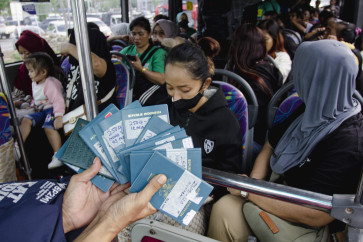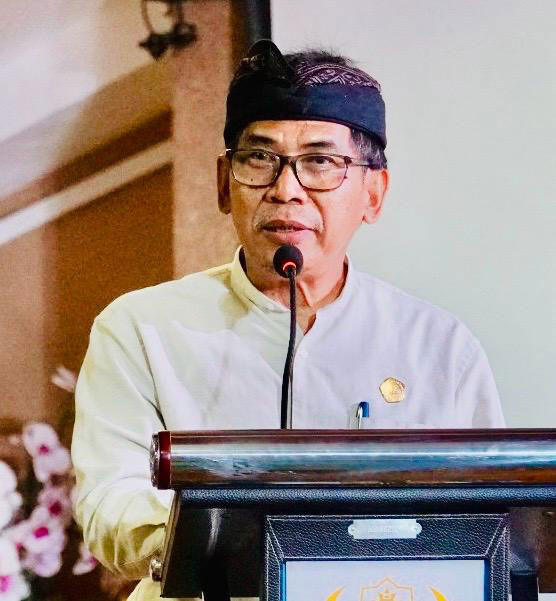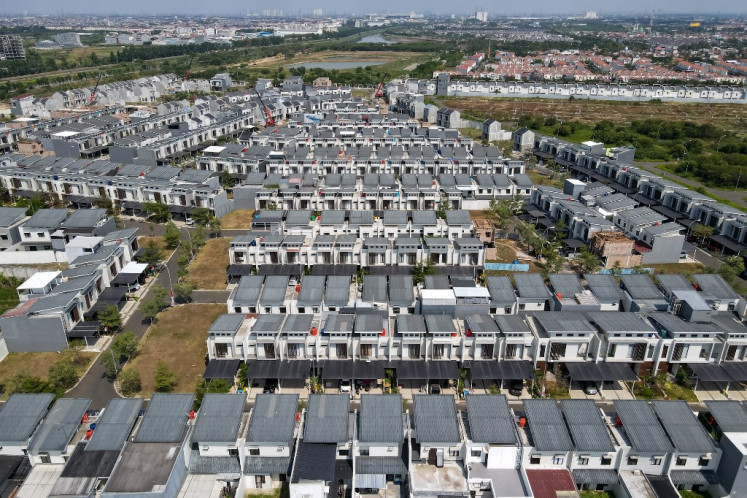Popular Reads
Top Results
Can't find what you're looking for?
View all search resultsPopular Reads
Top Results
Can't find what you're looking for?
View all search resultsImplementing happiness-based policy in Indonesia
Higher education leads to a higher level of happiness. People with no education have the lowest score of happiness while the ones with graduate levels of education have the highest happiness index ( 61.69 and 75.58, respectively). On the other side, young people are relatively happier than older people and married people tend to be happier.
Change text size
Gift Premium Articles
to Anyone
 Elementary school students participate in a hat festival at the Hotel Indonesia traffic circle in Central Jakarta in this undated photograph. (JP/-)
Elementary school students participate in a hat festival at the Hotel Indonesia traffic circle in Central Jakarta in this undated photograph. (JP/-)
T
he World Economic Forum (WEF) has recently proposed a new measurement standard of growth that is better than gross domestic product (GDP), as it considers good jobs, well-being, the environment, fairness and health.
These five indicators revealed by the New Economics Foundation (NEF) are trusted to be able to measure development indicators through all aspects of human life. The WEF stated that GDP is like a speedometer that tells us “how fast” we run, but it cannot tell us in “which direction” we are going.
In relation to the progressiveness of the well-being measurement, the Central Statistics Agency (BPS) also start to release the Indonesian happiness index, locally known as the Indeks Kebahagiaan, which measures the happiness and life satisfaction of Indonesian citizens. The latest survey in 2014 said that we reached 68.28 out of 100 on the happiness index.
In general, there are two types of well-being measurements, an objective measurement and a subjective one. Even though the happiness index is a subjective scale, it could be a better measurement tool than GDP since it can capture all aspects of life.
A 2004 study by academic Carol L. Graham explained the happiness variables, which include the number of children, income, health, marital status, gender, race, life cycle effect and optimal allocation of time and activities.
Another study in 2010 by economist Maarten Berg defines happiness according to some previous theories. English philosopher Jeremy Bentham’s theory said that happiness is the sum of pleasures and pains, while Dutch sociologist Valenhoven defines happiness as a subjective appreciation of one’s life as a whole.
Berg also defines happiness as life satisfaction, which has two components: affective (mood) and cognitive (to what extent life meets the standard they have in mind).
Indonesian happiness indexes use 10 indicators to define the well-being of individuals and society. They are health, education, jobs, household income, family, leisure time, social relationship, house and assets, the environment and safety.
From the latest survey in Indonesian happiness indexes, we capture some interesting results.
People who live in the cities or urban areas are happier than the ones who live in village or rural areas. It could be caused by the better facilities people get in the cities with respect to health facilities, education, job offers and entertainment for leisure time.
In educational aspects, higher education leads to a higher level of happiness. People with no education have the lowest score of happiness while the ones with graduate levels of education have the highest happiness index ( 61.69 and 75.58, respectively). On the other side, young people are relatively happier than older people and married people tend to be happier.
Related to the number of family members, families with only one member have the lowest score ( 62.32 ) while families with four members have the highest score ( 65.9 ).
However, the happiness index of families with more than five members decreased to around 64.53.
One of the greatest things about happiness indexes is that they can capture each aspect of life satisfaction for every individual. As I mentioned earlier, GDP only tells us about the amount of product we create while it does not tell us how members of society feel about their lives and how we can improve them.
With GDP, we know that we have to increase our productivity. With happiness indexes, we know which aspect of life we need to improve to meet everyone’s needs and maximize our happiness.
On the other side, this happiness index has not yet been widely used, especially for policy making processes. GDP, in line with some unemployment and poverty indicators, is still the main indicator to define whether we are in a good or bad economic situation. From now on, we should start using happiness-based policies to get a better measurement of well-being.
How can we implement the happiness-based policy in Indonesia?
The simplest thing to do is to formulate policy based on the results of the happiness indexes for each aspect of human life. It needs good research and studies in happiness variables and the relation with well-being. Therefore, both of government and scholars should work together to produce the best fit indicators of life satisfaction for Indonesian society.
Here are some examples of happiness-based policies according to the latest survey of Indonesian happiness indexes.
According to 2014 happiness index, we can see that people in urban areas tend to be happier than the ones in rural areas. From this fact, we conclude that government should give more attention to rural area development programs such as by increasing health facilities, education quality, infrastructure and so forth.
The second thing relates to the number of family members, which can be a base for child policy. Up to now, Indonesia has done massive campaigning for a Dua Anak Cukup (two are enough) program, which reveals that four family members create the highest level of happiness based on the happiness index 2014.
Then, related to the education level, happiness indexes prove that higher education leads to a higher happiness level.
Thus, government should support the program to increase education levels, such as free basic education (primary school, middle school and high school), with the addition of various kinds of scholarships not only to increase productivity, but also to increase society’s happiness by creating an open-minded generation in the future.
While many people say money cannot buy happiness, the opposite result is seen from Indonesian perspective. According to the survey of the happiness index, we conclude that high income people tend to be happier than the lower ones.
Therefore, government should stimulate job creation, increasing minimum wage proportionally, and help poor people to get their income through cash transfer policies.
If the ultimate goal of public policy is well-being, why do we not start to measure the well-being itself instead of using GDP? After all, in the future well-being studies and happiness-based policy will be the new ways to create better policy and to improve everybody’s lives.
***
The writer is a Master’s degree candidate in economics at the University of Illinois at Urbana-Champaign, US. She is also a researcher at the Institute for Development of Economics and Finance (INDEF), Jakarta.
---------------
We are looking for information, opinions, and in-depth analysis from experts or scholars in a variety of fields. We choose articles based on facts or opinions about general news, as well as quality analysis and commentary about Indonesia or international events. Send your piece to community@jakpost.com.









